Ham Hill is 170 million years in the making, offering fantastic views across the South Somerset Levels to the Mendips, Exmoor and beyond. A Nationally important Historic Monument, it is one of the largest Iron Age hillforts in the UK. Today, as well as, the 88.1 hectare Scheduled Ancient Monument, it offers beautiful wildflower meadows, spectacular wildlife, fascinating geology and striking Iron Age rampart archaeology.
Perched on a rocky outcrop of stone (hamstone) Ham Hill is easy to see from the A303 and it's 158 hectares offers something for everyone.
History
Ham Hill’s past is both rich and fascinating. Stone Age man first settled here over 5,000 years ago and lots of flint tools, including axes that were left behind have been discovered. This settlement continued throughout the Bronze Age and metalwork, pottery and evidence of burials have been discovered across the hillfort. Sitting above most of the surrounding landscape it would have offered commanding views of the countryside.
It was the Iron Age that truly shaped Ham Hill. Over 200 years, the local tribe, the 'Durotriges', crafted the steep sloping ramparts that can still be seen today with antler picks and small iron tools. There have been numerous Iron Age finds including iron currency bars, brooches, storage pits, pottery, burials and lots of skeletons!
Sometime after AD43, there was a change of ownership when the Roman army invaded and took over the hillfort. During their time, Romans built an army garrison, a 19 room villa and continued with construction of the Fosse Way that runs from Lincoln to Exeter, and sits under parts of the A303.
Moving forward, outlines of a deserted Medieval village can still be seen in Witcombe valley and there is a wonderful walk down to the medieval pond.
George Mitchell really put Ham Hill on the map in the 1870’s. Every Whitsun Monday, hundreds of workers would march to Ham Hill and demonstrate for fair pay and workers’ rights; with banners and marching bands.
Many of the finds that have been discovered at Ham Hill can be viewed at the Museum of Somerset in Taunton. More information can be found on the South West Heritage Trust website.
Geology and Quarrying
The geology of Ham hill is around 170 million years old and unique. Classified as a Jurassic shelly limestone, this golden, honey coloured stone, is a sedimentary rock that was built up in layers. Warm, shallow seas once covered the area and small fragments of shell, sea creatures and calcium carbonate, were cemented together on the sea floor by pressure and time.
This layer of rock is quite thin and sits on top of Yeovil sand - You are literally walking on the sea bed!
Hamstone layers are great for geologists to study and parts of the exposed stone outcrops at Ham Hill are protected as Sites of Special Scientific Interest or designated as Local Geological Sites. The stone is also great for building or carving and the Romans were the first people to quarry stone here in large quantities.
At its height in 1880, there were over 200 men employed in quarries here.
Hamstone, has been used to build most of the older houses in surrounding villages including some prominent ones like Sherborne Abbey and Montacute House. Earth mounds near the Ranger's Centre are old Victorian quarry spoil heaps. Also look out for large scratches on some of the stone faces that are old tool marks. They are reminders of Ham hill’s quarrying past.
More information on Somerset's geology can be found here
There are six public car parks situated across the site and are all accessible off the Ham Hill Road (TA14 6RW). There is disabled parking at the ranger centre (TA14 6RW).
Please note that the car park at the Prince of Wales pub is strictly for patrons only.
Please do not park along the roadside.
Dogs are welcome at Ham Hill and there are some lovely dog friendly walks right across the whole 390 acres.
However, grassland areas at the site are grazed periodically by cattle and sheep and all dogs must be kept on a lead when walking in these areas if livestock are present.
We also have a fantastic population of skylarks, which are ground-nesting birds and dogs must be kept on leads when the skylark signs are up too.
The Prince of Wales Public House is situated at the top of Ham Hill, approximately 200 metres from the ranger centre.
For their current opening times, contact details and menu samples please visit their website
Prince of Wales pub


Friends of Ham Hill
The Friends of Ham Hill are a charity that help to initiate community and environmental projects at Ham Hill, by raising funds and assisting the ranger team with the delivery of the projects. Previous projects have included the woodland play area, tree planting, Roman treasure trail, the geology trail and the Witcombe stream project. The group are currently looking at funding for a dragonfly pond in Witcombe valley.
If you would like to get involved with the Friends please contact [email protected]
Visit their website for more information or to donate for future projects.
Friends of Ham Hill website

There is a ladies, gents and a disabled toilet at the Rangers' Centre and they are open from dawn until dusk.
Access to the disabled toilet is via the use of a radar key.
Climbing
Yeovil Mountaineering Club have access to climbing at Deep Quarry on Ham Hill. For more information visit their website
Yeovil Mountaineering Club

Cycling is permitted only on the bridleways across the site.
Please be mindful and respectful of other visitors when cycling in the area.
Paths at Ham Hill are either stone, grass or bark but some are hilly due to the nature of the site.
Large parts across the Northern Spur and the Flat Fields are accessible for a mobility scooter and there is an all ability trail that runs around the Northern Spur and is wheelchair friendly; it is approximately 0.9km and has a maximum gradient of 11%.
Ham Hill Easy Access Trail
There are over 2,300 recorded species of flora and fauna scattered across a diverse mosaic of habitats to enjoy here.
 During the summer take a walk through our beautiful wildflower meadows to see southern marsh, pyramidal and bee orchids in their hundreds, broomrape, vetch, cranesbill and yellow rattle also carpet the meadows. Listen to crickets and skylarks as you watch meadow brown and common blue butterflies drift from grass stem to stem and watch as swifts and swallows dive along the grass tops trying to catch them and other insects.
During the summer take a walk through our beautiful wildflower meadows to see southern marsh, pyramidal and bee orchids in their hundreds, broomrape, vetch, cranesbill and yellow rattle also carpet the meadows. Listen to crickets and skylarks as you watch meadow brown and common blue butterflies drift from grass stem to stem and watch as swifts and swallows dive along the grass tops trying to catch them and other insects.

In other grassland areas, rare calcareous soils support many plant species including wild thyme and birds-foot trefoil where common blue, green hairstreak and skipper butterflies can be discovered.
The woodlands are host to many bird species including nuthatch, tree creeper and both green and great spotted woodpecker. On a warm summers day listen to buzzards mewing as they circle overhead. If you are lucky you may spot a roe deer or fox in the grasslands on the edge of the woodlands. Many species of bat can be seen at dusk with common and soprano pipistrelles feeding in the woodland rides whilst noctule and serotine can be seen on the woodland edge of the meadows. If you stay late enough to watch the bats, then also keep your eyes open for glow-worms in the grassland.
Visit the notice board at the Ranger Centre for recent wildlife sightings
Can I use a drone at Ham Hill?
Drone use is strictly regulated across all of our sites to prevent disturbance to the wildlife and so that the privacy of our visitors is respected. If you have a good reason for wanting to fly a drone across any of our countryside sites, you will need to email the Countryside Manager to request permission, along with a copy of your public liability insurance and certification to fly a drone.
Email Countryside Manager for permission to fly a drone
Can I have a BBQ or small campfire on site?
No.
Due to the high fire risk and detriment to the wildlife, barbeques and campfires are strictly prohibited at Ham Hill.
If you are organised group (scouts etc) you can apply for permission to have a BBQ or campfire by contacting the rangers. You must adhere to strict conditions and have a risk assessment and public liability insurance in place.
Email to ask permission for a BBQ or campfire




 Parking On-Site
Parking On-Site Cafe/ Restaurant
Cafe/ Restaurant Family friendly
Family friendly Dogs Welcome
Dogs Welcome Toilets
Toilets Free Entry
Free Entry Open All Year
Open All Year Picnic Area
Picnic Area Partial Disabled Access
Partial Disabled Access Play Park
Play Park Biodiversity diversity
Biodiversity diversity  Free Entry
Free Entry





 During the summer take a walk through our beautiful wildflower meadows to see southern marsh, pyramidal and bee orchids in their hundreds, broomrape, vetch, cranesbill and yellow rattle also carpet the meadows. Listen to crickets and skylarks as you watch meadow brown and common blue butterflies drift from grass stem to stem and watch as swifts and swallows dive along the grass tops trying to catch them and other insects.
During the summer take a walk through our beautiful wildflower meadows to see southern marsh, pyramidal and bee orchids in their hundreds, broomrape, vetch, cranesbill and yellow rattle also carpet the meadows. Listen to crickets and skylarks as you watch meadow brown and common blue butterflies drift from grass stem to stem and watch as swifts and swallows dive along the grass tops trying to catch them and other insects.
 "Uncovering Ham Hill's past for its future"
"Uncovering Ham Hill's past for its future" 


 or your community group (scouts, guides, brownies, U3A etc.)
or your community group (scouts, guides, brownies, U3A etc.) 
